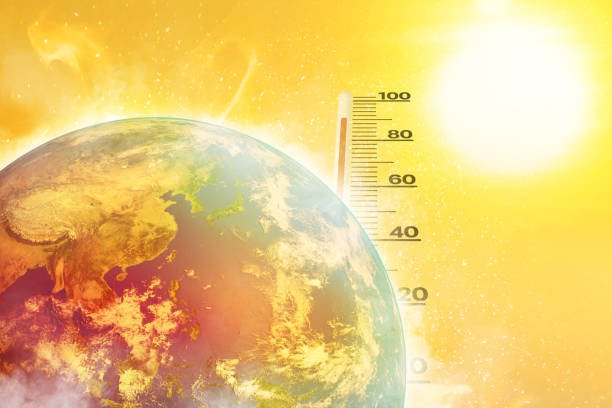
Introduction: The Growing Threat of Rising Temperatures
Rising Temperatures and Their Impact on Future Generations: Rising temperatures are one of the most pressing issues our planet faces today. This issue is not a distant future concern; it’s already happening. Global warming is causing profound changes to ecosystems, economies, and societies. While the current generation has already begun to experience these impacts, future generations will face even more significant challenges if the problem is not addressed.
This article will explore the causes, effects, and potential solutions to the problem of rising temperatures. It will focus on how global warming affects human societies, ecosystems, agriculture, and health. Future generations are at risk of living in a world with harsher climates, extreme weather events, and devastated ecosystems. The following sections will highlight why we need to take immediate action to ensure the future is not irreparably damaged.
What Causes Rising Temperatures?
Rising temperatures are primarily caused by an increase in greenhouse gases (GHGs) in the Earth’s atmosphere. These gases trap heat from the sun and cause the Earth to warm up. The main contributors to rising temperatures are:
- Carbon Dioxide (CO2): The burning of fossil fuels such as coal, oil, and natural gas for energy, transportation, and industrial activities produces large amounts of CO2. Deforestation also contributes to higher CO2 levels as trees absorb carbon dioxide.
- Methane (CH4): This gas is released during the production and transport of coal, oil, and natural gas. Methane is also produced by livestock and other agricultural practices. Methane is more potent than CO2, though it exists in lower quantities.
- Nitrous Oxide (N2O): This gas is produced by agricultural and industrial activities, particularly the use of fertilizers. Nitrous oxide has a much higher global warming potential than carbon dioxide.
Human activities, particularly industrialization and deforestation, have significantly increased the concentration of these gases in the atmosphere. As a result, the Earth is warming faster than at any point in human history.
How Rising Temperatures Will Impact Future Generations
The effects of rising temperatures are already visible today, but future generations will experience them in more extreme and devastating ways. Some of the most significant impacts of rising temperatures are:
1. Extreme Weather Events
One of the most noticeable consequences of rising temperatures is an increase in extreme weather events. Heatwaves, storms, droughts, floods, and wildfires are becoming more frequent and intense. As temperatures continue to rise, future generations will face more dangerous and unpredictable weather patterns.
For instance, heatwaves will become longer and more severe, putting stress on vulnerable populations, particularly the elderly and children. The heat will also strain energy systems, particularly during summer months when demand for cooling increases.
Storms will also become more intense. Hurricanes, typhoons, and cyclones are expected to become stronger due to higher sea surface temperatures. Coastal areas will be increasingly at risk from storm surges, flooding, and erosion. Future generations will have to cope with the aftermath of more frequent natural disasters, leading to the displacement of millions of people worldwide.
Rising Temperatures and Their Impact on Future Generations.
2. Rising Sea Levels
Rising temperatures contribute to the melting of polar ice caps and glaciers. As ice melts, the volume of water increases, raising sea levels. According to projections from the Intergovernmental Panel on Climate Change (IPCC), global sea levels could rise by up to one meter by the end of this century if current trends continue.
Coastal communities will face severe challenges. Many low-lying regions will become uninhabitable due to flooding and saltwater intrusion into freshwater sources. Entire cities and islands may disappear underwater. This will create millions of climate refugees, forcing future generations to deal with the social, economic, and political consequences of such mass displacement.
3. Impact on Biodiversity
Rising temperatures will also have a devastating impact on global biodiversity. Many species of plants and animals are highly sensitive to temperature changes. If temperatures rise too quickly, many species will be unable to adapt or migrate. As a result, large numbers of species could face extinction.
Coral reefs, for example, are highly vulnerable to temperature increases. When ocean temperatures rise, coral reefs experience coral bleaching, a condition where the coral expels the algae that provide it with food. If temperatures rise beyond a certain threshold, entire coral reef ecosystems could collapse. This would have severe consequences for marine biodiversity, fisheries, and tourism industries that depend on coral reefs.
The loss of biodiversity will disrupt ecosystems and the services they provide, such as pollination, water purification, and climate regulation. Future generations will inherit a planet with fewer species and diminished ecosystems, making it harder to maintain human and environmental health.
4. Health Risks
Rising temperatures will also pose significant health risks to future generations. The most immediate impact is on the increase in heat-related illnesses. Prolonged exposure to high temperatures can lead to heatstroke, dehydration, and other heat-related illnesses. These risks are particularly high in urban areas, where temperatures tend to be higher due to the urban heat island effect.
Climate change will also influence the spread of infectious diseases. Warmer temperatures will expand the range of disease-carrying insects, such as mosquitoes. Diseases like malaria, dengue fever, and Zika virus will spread to new regions, putting more people at risk.
Air quality will also suffer. Rising temperatures can exacerbate air pollution by increasing the formation of ground-level ozone, which can cause respiratory problems. Children, the elderly, and people with pre-existing health conditions will be especially vulnerable to poor air quality.
5. Food Security
Agriculture is highly sensitive to climate change. Rising temperatures will affect crop yields, especially in regions that are already warm. Droughts, floods, and changing rainfall patterns will disrupt the production of key crops like wheat, rice, and maize. This will lead to food shortages and higher food prices.
As global temperatures rise, regions that rely on agriculture for survival will face greater challenges. Future generations will need to find ways to produce food in an increasingly unpredictable climate. Innovations in agricultural technology, such as drought-resistant crops and precision farming, will be essential in meeting the food needs of future generations.
Rising Temperatures and Their Impact on Future Generations.
6. Water Scarcity
Water scarcity is another major concern as global temperatures rise. Higher temperatures increase evaporation rates and reduce the availability of freshwater resources. Droughts will become more frequent and severe, affecting water supplies in many regions of the world.
The growing demand for water, combined with reduced availability, will put pressure on freshwater systems. Future generations will face significant challenges in securing access to clean drinking water and water for agriculture and industry. This may lead to conflicts over water resources, particularly in arid regions.
Economic Consequences for Future Generations
The economic costs of rising temperatures will be immense. Future generations will inherit an economy deeply impacted by climate change, with many industries facing severe disruptions. Some of the most significant economic consequences include:
1. Damaged Infrastructure
Extreme weather events and rising sea levels will cause damage to infrastructure, such as roads, bridges, buildings, and energy systems. Rebuilding and maintaining infrastructure in a climate-impacted world will be costly, diverting resources away from other important needs.
In addition to direct infrastructure damage, the costs of adapting infrastructure to cope with climate change will also rise. Future generations will need to invest heavily in resilient infrastructure to protect against floods, storms, and heatwaves.
2. Increased Health Care Costs
The health impacts of rising temperatures will strain healthcare systems worldwide. The increased prevalence of heat-related illnesses, infectious diseases, and respiratory problems will lead to higher healthcare costs. Future generations will need to allocate significant resources to public health systems to address these challenges.
The economic burden of climate-related health problems will be particularly felt in developing countries, where healthcare infrastructure is already limited. As a result, future generations will face challenges in providing affordable and adequate healthcare services to growing populations.
3. Job Losses in Vulnerable Sectors
Some sectors, such as agriculture, fishing, and tourism, will be hit hardest by climate change. Extreme weather events, crop failures, and the destruction of natural resources will lead to job losses in these industries. Future generations will need to find ways to transition workers into new, climate-resilient industries, such as renewable energy and environmental engineering.
4. The Cost of Climate Adaptation
Adapting to climate change will require significant investment in new technologies, infrastructure, and policies. Future generations will have to bear the financial burden of mitigating the impacts of rising temperatures and adapting to the changing environment.
What Can Be Done to Mitigate Rising Temperatures?
Mitigating the effects of rising temperatures is crucial to ensuring that future generations inherit a livable planet. Some of the key strategies for mitigating climate change include:
1. Reducing Greenhouse Gas Emissions
The most effective way to mitigate rising temperatures is by reducing the emissions of greenhouse gases. This can be achieved by transitioning to renewable energy sources, such as wind, solar, and hydropower. Energy efficiency improvements in industries, homes, and transportation are also essential.
Governments, corporations, and individuals all have a role to play in reducing carbon emissions. Strong policies, such as carbon pricing and emissions regulations, can drive the transition to a low-carbon economy.
2. Protecting and Restoring Ecosystems
Protecting forests, wetlands, and oceans can help absorb carbon dioxide from the atmosphere and reduce the impacts of climate change. Reforestation and afforestation efforts can increase carbon sequestration and improve biodiversity, making ecosystems more resilient to climate impacts.
3. Investing in Climate-Resilient Infrastructure
Building climate-resilient infrastructure is essential for adapting to the impacts of rising temperatures. This includes designing buildings and infrastructure that can withstand extreme weather events, upgrading water systems to cope with droughts, and constructing flood defenses.
4. Promoting Global Cooperation
Climate change is a global issue that requires a collective response. Future generations will benefit from the global agreements we make today. The Paris Agreement, for example, aims to limit global warming to below 2°C above pre-industrial levels. Strong international cooperation will be necessary to ensure that emissions are reduced, and climate adaptation efforts are shared across nations.
Conclusion: A Call to Action
Rising temperatures are a critical issue that demands urgent action. Future generations will face severe challenges, but we still have time to act. By reducing greenhouse gas emissions, investing in sustainable practices, and protecting ecosystems, we can mitigate the worst impacts of global warming. It is our responsibility to ensure that future generations inherit a planet that is livable, sustainable, and resilient. Together, we can rise to the challenge and create a better future for all.
